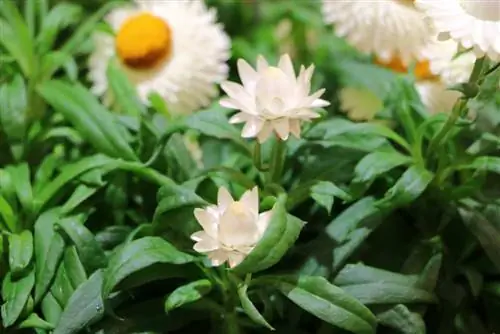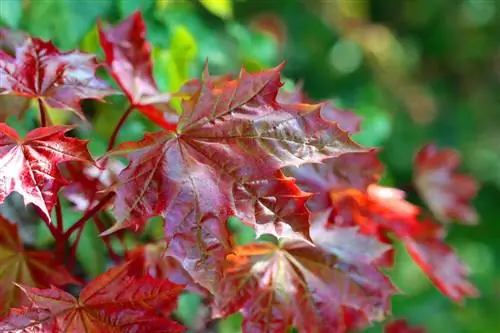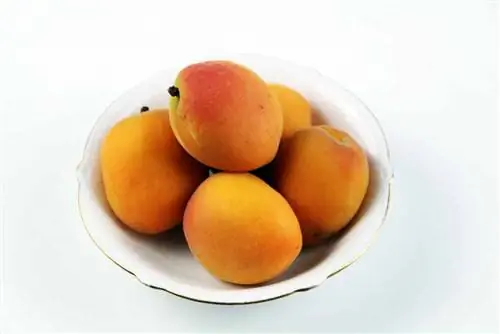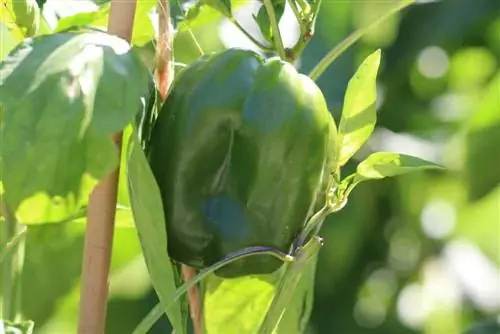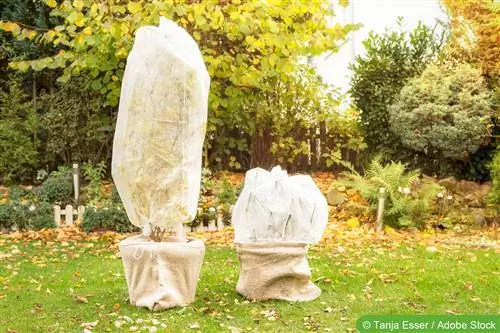- Author admin [email protected].
- Public 2023-12-17 03:39.
- Last modified 2025-06-01 06:48.
Straw flowers (Helichrysum) are only known to many people from dry arrangements, but they are also a visual eye-catcher when fresh in the garden. Strawflowers come in a wide variety of colors and delight the eye with their splendor in the garden. The advantage is that straw flowers can be used both as decorative borders and at the same time as dried flowers in the house.
variety selection
There are around 600 different types of strawflowers, which are very different in their growth form and flowering. In addition, they also have different requirements for their location and care. The most well-known strawflower is the garden strawflower (Helichrysum bracteatum), which is also used as a dried flower. The straw flowers also include curry herb, which is often sold as a spice plant. The so-called licorice herb or silver straw flower also belongs to the genus Helichrysum. Many strawflower species come from warm countries and are therefore not frost-resistant. The garden strawflower, on the other hand, can also tolerate light frosts, but it has to be brought indoors for severe winters.
Location
Strawflowers require very nutrient-rich soil, which is why the plants must be provided with sufficient compost or other organic fertilizers. Waterlogging must also be prevented, which can be achieved simply by adding sand to the substrate. The location itself should be sunny and warm. If strawflowers are planted together with other plants in the bed, they should always be in the first row, as on the one hand they reach heights of up to around 60 cm and on the other hand they always get enough sun. Strawflowers also tolerate the blazing midday sun without any problems and are therefore suitable for locations where other plants would often only thrive poorly in the blazing sun.
Sowing
- Pre-culture: Since strawflowers do not appreciate cool temperatures, they should be grown indoors from March or April at the latest. Cover seeds only lightly with soil. From April onwards, the strawflowers can also be sown in the cold frame.
- Germination temperature: The germination temperature should be around 18°C.
- Germination time: The seeds need around 14 days to germinate.
Tip:
Pre-cultivation of strawflowers should not be started before March, as the roots of the plants could suffer in the small cultivation trays.
- Outdoor: After the last frosts from mid-May, the plants from the pre-culture in the house or cold frame can be released into the beds. When planting out, care should be taken to ensure that the strawflowers have enough space between them so that they can develop well.
- Direct sowing: From mid-May, the strawflowers can also be sown directly outdoors. However, these plants are usually significantly smaller and side shoots must be removed regularly so that some large flowers can develop. During cultivation, care must be taken to ensure that the seedlings neither dry out nor are too moist, otherwise they could rot.
Tip:
Plants in pre-culture should be pricked out. In a nutrient-rich substrate and with plenty of space, the plants can develop significantly better in the pre-culture and grow into more beautiful perennials.
Care
Straw flowers are very undemanding and require little care. Withered and dried plant parts must be removed regularly. If this is not the case, dead plant parts can start to mold in wet months and damage the strawflowers. The strawflowers can be cut back regularly, which means the rest of the plant will grow even stronger.
Tip:
Straw flowers should no longer be cut shortly before winter. Only in the spring after overwintering should a strong pruning be carried out.
- Watering: Strawflowers love dry soil, but cannot do without water entirely. Do not use cold water - it is best to water with rainwater from the barrel in the morning or evening. Do not water during the blazing midday sun as the drops act like a lens on the plant and the leaves can be burned by the sun. So that the soil of the strawflowers does not dry out too quickly, it can also be covered with a layer of bark mulch, which can be used to optimally regulate the moisture balance. Basically, when it comes to strawflowers, it's better to water them a little and more often so that waterlogging doesn't form.
- Fertilizing: Strawflowers should be fertilized at least three times a year. When planting, the soil can be prepared with organic fertilizer such as compost. Approximately every three months, the strawflowers are supplied with nutrients again with liquid fertilizer so that they can develop well and produce many flowers.
Propagation
Strawflowers are propagated from seeds, which you can easily grow yourself. To do this, faded flowers are not cut off - however, unnecessary side shoots should be removed so that the plant puts the energy into producing seeds from a few inflorescences. To prevent the seeds from sowing themselves, an old silk stocking can be placed over the flower heads shortly before they ripen, which prevents the wind from blowing the seeds away. The seeds are stored dry and cool indoors and sown again next spring.
Wintering
Annual strawflowers will definitely move in in the fall and will rarely grow again the next year. Although perennial strawflower species tolerate cool temperatures, frost also damages them. To overwinter, the strawflowers are transplanted into a pot and kept in a cool and bright room. Stairwells, frost-free garages or unheated winter gardens are suitable for this. Water only occasionally. The substrate should be kept slightly moist, but no waterlogging should occur. Do not fertilize in winter as this will bring the plants out of their dormant phase prematurely.
Tip:
Although it is possible to overwinter strawflowers, they only survive under favorable conditions. It therefore makes more sense to harvest seeds in autumn and sow them again every year.
Diseases and pests
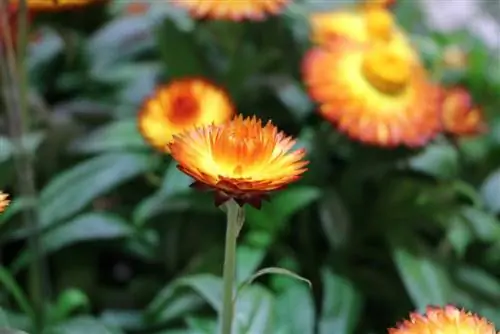
Straw flowers are usually not very susceptible to pests and diseases. Occasionally, individual aphids can be found on the plants, but as long as they do not appear in large groups, they do not pose a danger to the plants. Occasionally, downy mildew can also attack the plants. Here, too, it is rarely necessary to use pesticides - it is usually enough to simply cut off the affected parts of the plant and dispose of them. If the plant loses leaves or begins to wilt, these are usually signs of incorrect care.
Frequently asked questions
How are straw flowers dried?
It is important when drying the strawflowers that they are not cut off too early or too late. The best time to prune is mid-bloom, when the first petals have just opened. Cut flowers are then hung up to dry in an airy place.
Can strawflowers be grown in pots?
Straw flowers can be easily cultivated in pots. However, it should be noted that the plants need to be watered and fertilized much more frequently. Growing in a pot or bucket also makes overwintering easier, as the roots of the plants are not unnecessarily damaged by repotting. When growing in a pot, it should not be too small, otherwise the maintenance effort will be much greater.
What you should know about the strawflower in brief
Drying
Although there are many different types of strawflowers, the garden strawflower is the best known and if you want to dry the flowers, this type is best. Its flowers do not have real petals, but rather paper-like bracts that have a very long shelf life when dried. This property makes the strawflower a very popular dried flower and also gave it its German name.
- To dry, the flowers are cut on long stems that are already slightly open on the outside, but whose heart is still closed.
- If the flower is already too wide open, the center of the flower turns black, then it is unsuitable for drying for optical reasons.
- The leaves are then removed and the flowers are hung upside down either individually or in a bouquet.
- A good option for this, for example, is a clothesline in an airy, shady place.
Sowing
- Straw flowers can be grown indoors from seeds from the end of March to April.
- Only cover seeds lightly with soil. Germination time 12-14 days at 16-18 °C.
- Do not sow beforehand, otherwise they will remain in narrow seed trays for too long and the roots will suffer!
- After the late frosts, plant outdoors with a plant and row spacing of 25 cm.
- In April, strawflowers can also be sown in the cold frame.
- The resulting plants are particularly strong and delight with very early flowering.
- After the Einshelligen they can then leave their cold frame and be placed in their actual destination.
- You can sow directly on site in May.
Tip:
Strawflowers prefer rather dry soil, especially in full sun. Only Helichrysum petiolare prefers a shady, cool spot. Annual plants in particular are hungry and need a lot of nutrients.
Seeds can also be collected from existing plants. The seeds sprout after about a week and remain germinable for about 2 years.
Wintering
There are a variety of different species, some of which are annuals. The other species are perennials, most species of which are sensitive to frost. Only a few are frost-resistant and can survive the winter outdoors. If there are any doubts about the species and variety, the strawflower should be kept frost-free in a dark cellar over the winter as a precaution. The most common types and their winter hardiness:
- Curry herb (Helichrysum italicum) (syn. Helichrysum angustifolium): Evergreen subshrub that only survives the winter outside in very mild areas. It can be left outside in protected places with winter protection without pruning and can easily tolerate temperatures down to -5 °C. Older plants are more frost resistant. It is safer to keep it over the winter in a cool, dark cellar.
- Garden strawflower (Helichrysum bracteatum): The best-known and most popular species. It is usually cultivated as an annual, but is still considered to be partially hardy as the first light frost cannot harm it. Some, especially newer varieties, have been specially bred for winter hardiness and can withstand the frost outside well. To do this, cut the plants back by 2/3, although the remaining stems should not be less than 10 cm high. A careful covering of brushwood makes sense.
- Liquorice herb - silver straw flower (Helichrysum petiolare) (syn. Helichrysum petiolatum hort.): Cushion-forming subshrub. Prefers cooler temperatures in the shade, but is only partially hardy. The first light frosts are tolerated well; in mild regions it can survive mild winters even outside with protection. To avoid failures, the silver straw flower should overwinter frost-free in a cool cellar.
- Helichrysum splendidum (syn. Helichrysum alveolatum, Helichrysum trilineatum): Hardy species that is nevertheless grateful for a light cover with brushwood, especially in barfrost (frost without snow).

